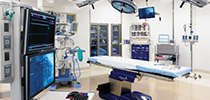OHH News
Posted on October 23rd, 2017
The vagus nerve is the longest of 12 cranial nerves and extends from the brainstem through the chest to the abdomen on each side of the body. It functions as part of the involuntary nervous system that controls unconscious processes in the body, such as regulating heart rhythm, regulating breathing, and digesting... Read More
Posted on October 10th, 2017
Heart block is an abnormal heart rhythm where the heart beats too slowly, which results in the electrical signals being partially or totally blocked between the upper chambers (atria) and lower chambers (ventricles). Heart block is also called... Read More
Posted on September 16th, 2017
The pericardium consists of two thin layers of tissue surrounding the heart that help hold the heart in place and help it function. There is a small amount of fluid between the two layers of tissue to prevent friction.
Pericarditis is inflammation of the pericardium, which can be either acute or chronic. The most common... Read More
Posted on September 11th, 2017
Cardiac implantable electronic devices (CIEDs) such as pacemakers and defibrillators can be life-saving devices for many patients with irregular heart rhythms. But as with any device or implant, there is also a small... Read More
Posted on August 20th, 2017
There are times when a patient experiences some degree of cardiac symptoms in their daily life but an in-office exam and electrocardiogram (ECG) don’t show any problems.
In situations like these, your heart specialist may recommend one of several types of stress test, which helps measure how your heart... Read More
Posted on August 10th, 2017
Cardiomyopathy is a disease of the heart muscle in which it becomes enlarged, thick, or rigid. As it progresses, the heart weakens and cannot adequately pump blood through the body, which can lead to irregular heart rhythms and heart failure.
This disease can develop over time as a result of other factors or can be genetic. The cause of cardiomyopathy is often unknown, and it can affect all... Read More
Posted on August 2nd, 2017
An MRI, or magnetic resonance imaging, is frequently used to diagnose a range of health issues. An MRI is the best possible diagnostic test for soft tissue disorders. This includes brain disorders, such as stroke or tumors, along with back and spine disorders. MRI is frequently... Read More
Posted on July 20th, 2017
Posted on July 6th, 2017
An ultrasound is a specific imaging tool used to diagnose and monitor a wide range of health conditions, including everything from pregnancy to tendon damage to heart disease. A probe that emits ultrasound beams is used to capture real-time images on a screen. Unlike x-rays or CT scans, there is no radiation involved in an ultrasound.
At the Oklahoma Heart Hospital, there are two primary... Read More
Posted on June 15th, 2017
The carotid arteries are the blood vessels on either side of the neck that primarily deliver blood to the brain. Carotid artery disease, also called carotid artery stenosis, occurs when these arteries become narrow due to the buildup of fatty substances and cholesterol deposits, which are commonly called plaque. As this plaque builds over time, it can restrict blood flow to the brain, which may... Read More













